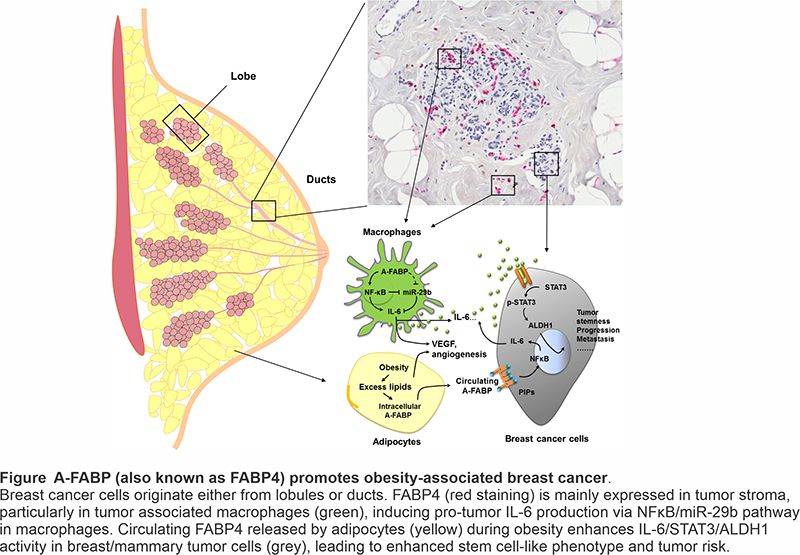
Breast cancer is the most frequent cancer diagnosed among women and there has been a progressive rise in breast cancer incidence in the last few decades. Despite improvements in early detection and treatment, breast cancer annually claims the lives of around half-a-million women worldwide mainly due to metastasis. Even for women with early stage breast cancer, around 40% of patients have micrometastatic tumor cells after surgery. Current therapies are frequently insufficient to completely eradicate residual dormant cancer cells, and triggers promoting the exit of dormancy of tumor cells remain poorly defined. Therefore, uncovering novel mechanisms for breast cancer development and recurrence and identifying new targets for breast cancer prevention and treatment represent critically important foci in the field of breast cancer research.
Obesity has risen at an alarming rate in recent decades due to a sedentary lifestyle in modern society and excess intake of dietary calories, including overconsumption of high fat diets (HFD). Given the prevalence of obesity and rising incidence of breast cancer, there is an urgent need to identify biological mediators underlying obesity-associated breast cancer.
A Novel Hypothesis: A-FABP as Driver of Obesity-Associated Breast Cancer
To facilitate absorption and utilization of water-insoluble dietary long-chain fatty acids (FA), an evolutionarily conserved protein family known as fatty acid binding proteins (FABPs) is expressed in various tissues. The FABP family consists of at least nine members, each with a distinct tissue expression pattern, such as adipose FABP (A-FABP/FABP4). FABPs function to solubilize various FA and coordinate their trafficking and responses inside cells. Depending on the cellular and tissue environment, individual FABPs exhibit unique biological functions by regulating different metabolic and inflammatory signaling pathways. A-FABP has attracted the most attention in the field of obesity due to its high expression in adipose tissue and biological functions in macrophages and adipocytes. In macrophages A-FABP modulates inflammatory responses through activation of NF-κB (nuclear factor κB) and JNK (c-Jun N-terminal kinase) pathways. In adipocytes FABP4 promotes lipolysis and inhibits lipogenesis through interactions with HSL (hormone-sensitive lipase) and PPARγ (peroxisome proliferator-activated receptor). Compared to lean individuals, A-FABP is upregulated in the adipose tissue and increasingly released into the circulation of obese patients. It is well-established that circulating serum A-FABP is positively associated with body mass index, and exerts hormonal regulations in obesity-associated diseases. Recent studies identified a critical role for A-FABP in pro-tumor macrophages and in enhancing obesity-associated breast cancer development in mouse models and human studies. In this project we thus hypothesize that A-FABP plays a central role in the regulation of metabolism, especially in obese individuals and represents a link between obesity and breast cancer risk.